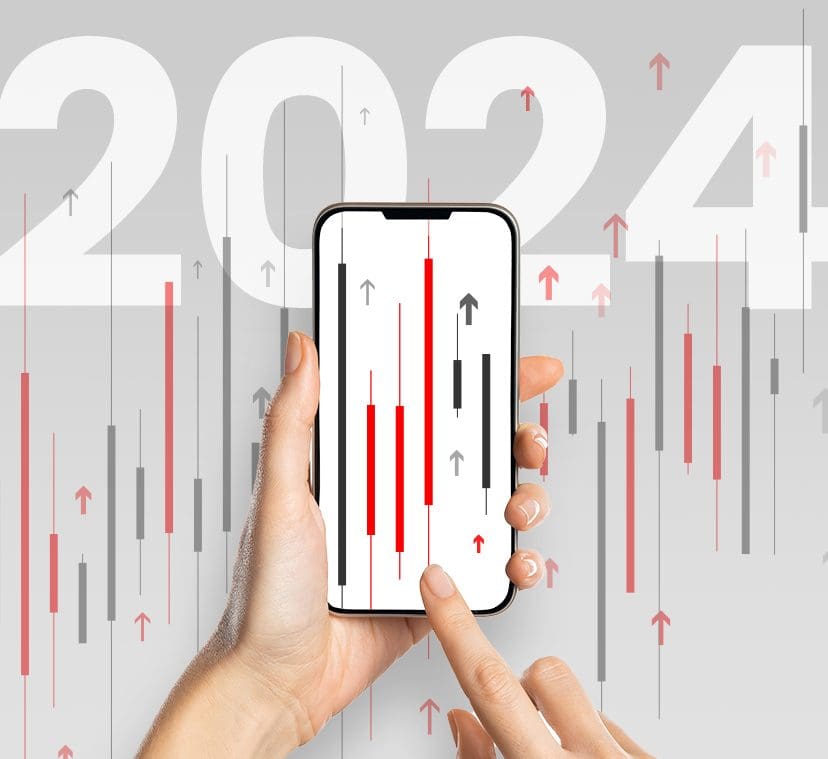
B2B Ecommerce Trends: What To Expect in 2024

Marketing Team
k-ecommerce
From purchase processes to automation tools, the B2B ecommerce market is ever-evolving. As 2024 begins, it’s good to look at emerging changes to prepare your B2B business for the new year.
Our guide highlights some of the biggest upcoming B2B ecommerce trends to help you leverage them to maximize sales and profits in 2024.
Here’s what you’ll learn:
Future of B2B Ecommerce: Trends To Watch Out For
In 2024, the B2B ecommerce market is expected to change quickly. As more millennials and Gen Zs take up decision-making positions in B2B companies, the purchase process will continue its digital transformation with a continuing shift to mobile devices.
Higher levels of automation and AI adoption will continue as manual interventions in the B2B sales process decrease. Plus, B2B marketing and sales will reach levels of customer-centric customization once only considered in B2C as buyers demand more personalization and payment options.
Here’s a more detailed look at how 2024 trends will look for B2B companies:
1. Self-Serve Digital Solutions
B2B buyers will be more inclined to purchase without sales reps using self-serve digital tools. In fact, even last year, only 25% of B2B buyers consulted sales reps before purchasing.
Many B2B buyers rely on product demos and trial accounts, as well as their own prior experience, to make a purchase.
Though this change had already begun post-pandemic, it’s expected to accelerate in 2024.
What’s Driving the Change?
The pandemic pushed companies towards hands-off sales and purchases, and those changes continue to spread.
With Gen Z and millennials gaining more decision-making positions, customer expectations continue to shift. These tech-savvy generations prefer digital processes more than engaging with people face-to-face.
They also want a quicker sales cycle with minimal steps, which is possible through self-service portals.
What Should B2B Companies Do?
Invest in self-serve tools to benefit both the business and the customers. Vendors can invest in digital resources like free trials and product demos that equip buyers to complete the purchase on their own.
Additionally, sellers can also leverage self-serve portals that offer instant personalized experiences for B2B buyers without requiring them to engage with sales reps.
2. Sustainability
Just like B2C customers, B2B customers are also increasingly buying from companies that are sustainable and enable ethical buying.
For example, in an attempt to reduce emissions throughout the supply chain, B2B buyers want companies to innovate to reduce CO2 emissions. They are also willing to pay more to buy from sustainable companies.
What’s Driving the Change?
As climate change and global warming concerns increase, people are becoming more aware of the environmental impacts of products and services. Large corporations want to become more responsible in keeping climate change at bay for cost savings and to foster customer loyalty.
What Should B2B Companies Do?
B2B sellers can look for green alternatives wherever possible in the sales cycle. For example, they can use recyclable material for packaging instead of using plastic. Sustainable practices like minimizing waste during production and delivery decrease the overall price of procurement.
Companies may also become certified for minimum emissions and contribute to green initiatives either monetarily or through involvement and promotions to support customer values.
3. Automation
One of the most notable B2B ecommerce trends is the use of automation tools throughout the ecommerce processes to free up time that companies can spend on strategy. These tools simplify accounting, order and sales management, marketing, analytic functions, and also help save human resource costs.
In 2023, 42% of B2B companies used AI and automation for marketing, and this trend should accelerate increase in the coming year.
What’s Driving the Change?
By investing in automation, businesses can do more work in less time, at a lower cost, and with fewer staff members without affecting the overall quality.
Automation also helps provide omnichannel experiences, build ecommerce sites, and use real-time analytics for ecommerce strategies without requiring constant human intervention, which also reduces errors from manual functions.
What Should B2B Companies Do?
B2B brands must reevaluate their technological needs and partner with service partners like k-ecommerce, simplifying B2B automation.
They also need to automate ecommerce business processes like inventory management, analytics, and marketing to boost working efficiency, save costs, and also provide a better customer experience.
4. Mobile First, Desktop Second
Shifting from desktop devices to smaller screens like smartphones and tablets is an important B2B ecommerce trend in 2024. According to Statista, 60% of ecommerce sales to all audiences are expected to happen on mobile devices in 2024.
While B2C has strongly embraced digital commerce for a while, this is an emerging trend for online B2B sales as buyers look for the same experiences as work that they enjoy in personal shopping.
What’s Driving the Change?
Most young decision-makers start their B2B purchase research on their smartphones and are comfortable closing deals on the small screen without involving a sales team.
Many companies are also moving to providing tablets and smartphones to decision-makers instead of laptops for convenience and cost reduction, shifting the entire sales process to mobile devices.
What Should B2B Companies Do?
As B2B decision-makers use mobile phones at every step of the online sales process, companies need to optimize their marketing strategies to be mobile-friendly. This includes creating mobile apps and providing purchase options for mobile devices.
They also need to invest in mobile-optimized tools like k.ecom that help you simplify the B2B purchase process, even on smartphones.
5. More Payment Options
In the coming year, B2B buyers are expected to prefer companies that provide flexible payment options.
These options include payment methods like credit cards, online transfers, and e-wallets, plus tailored payment plans like installments, loans, and subscriptions.
This is crucial for both B2B buyers and sellers as B2B purchases generally involve large orders of high monetary value.
What’s Driving the Change?
B2B buyers are more cautious while spending on big-ticket orders. Some new customers may also not be able to afford entire orders upfront.
International B2B customers also want to pay in their local currencies to simplify accounting and avoid exchange fees instead of using the distributor’s currency on B2B marketplaces.
What Should B2B Companies Do?
Since B2B sales usually involve large totals, sellers should carefully plan their payment options.
You need to meet the customers’ payment needs by providing flexible plans while ensuring payment security.
Choosing a PCI-compliant payment platform like KIP helps you offer secure and versatile payment options while automating processes.
6. Greater Personalization
Like B2C, B2B buyers want a highly personalized sales process that includes targeted advertising, tailored resources, and customized buying plans.
In the coming year, businesses will increasingly purchase from B2B companies that provide a dedicated user experience for the entire decision-making panel.
What’s Driving the Change?
As the B2B buying process turns digital, the distinction between B2B and B2C sales has blurred. Millennials are already experiencing personalization in their personal B2C shopping and want the same from B2B.
The digital process also equips millennial decision-makers with many options, so personalization becomes a key differentiator.
What Should B2B Companies Do?
The B2B sales channels offer several opportunities for personalization, such as:
- Providing recurring order packages
- Displaying personalized pricing for each account
- Choosing relevant digital channels such as email and social media for marketing
Refer to our detailed B2B ecommerce personalization blog to provide the best buying experience for your buyers.
7. Machine Learning and AI
To facilitate automation and personalization, B2B ecommerce companies are investing in AI and machine learning tools. According to Coveo, 61% of B2B business owners planned to increase spending on AI tools in 2023.
B2B companies rely on AI to increase profits by reducing manual interventions, improving workflow efficiency, and providing accurate insights through analytics.
What’s Driving the Change?
The generative AI boom in 2023 has encouraged many companies to invest in AI and machine learning to stay ahead of the competition, partially because everyone else was doing it.
As it’s a new tool, B2B companies are experimenting with artificial intelligence in various business processes. However, no one can predict the long-term impact of AI on B2B sales yet.
What Should B2B Companies Do?
B2B companies can explore using AI in several ways to streamline their marketing and sales processes.
AI can help analyze competitor businesses, customers’ journeys, and previous sales data to create better customer experiences, suggest investments, and forecast product performances.
However, some AI requires considerable investment. So, businesses need to evaluate their sales processes and equip AI tools only where necessary.
8. Vertical Marketplaces
With the growing focus on customer-centric business models, vertical marketplaces are becoming more common in the B2B ecommerce landscape. By grouping niche industries together, buyers and sellers save time and money.
Mark Brohan, Senior VP at Digital Commerce 360 says that they found that the number of vertical B2B marketplaces has grown 6.7 times in the last 16 years. While horizontal marketplaces are still profitable, companies continue to niche down with vertical marketplaces.
What’s Driving the Change?
Vertical marketplaces aggregate brands from a single niche and attract more qualified leads interested in the particular vertical.
While B2C companies must cast a wide net in marketing, vertical B2B brands can spend resources on providing a more personalized shopping experience instead of chasing cold leads. The focus becomes standing out from your direct competitors instead of competing for attention with every company on the internet.
What Should B2B Companies Do?
B2B sellers need to shift their focus to vertical sales channels for more efficient use of resources in one niche.
As part of that shift to vertical marketplaces, companies must also focus on opportunities for personalization to strengthen customer loyalty. B2B companies must develop a dedicated sales strategy to attract, sell, and retain high-quality leads from select sectors.
Final Thoughts: Top 8 B2B Ecommerce Trends for 2024
In the upcoming year, the B2B ecommerce market will largely be driven by millennial decision-makers and automation.
You can leverage these B2B ecommerce trends to increase sales and profit by choosing an ecommerce solution that caters to modern customer preferences.
k.ecom is an ERP-integrated ecommerce solution that helps you automate and personalize B2B business processes to cater to your customers’ needs.
Since k.ecom directly integrates with your existing ERP, your data remains safe as no third-party connectors are needed. With k.ecom, you can streamline marketing, manage your ecommerce store, and add personalized payment options to help improve your B2B business.
Prepared to embrace the B2B trends in 2024? Contact us today.



